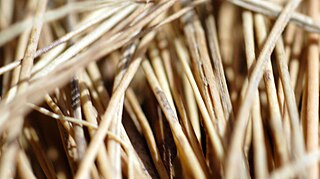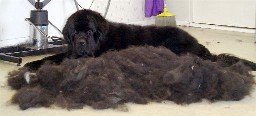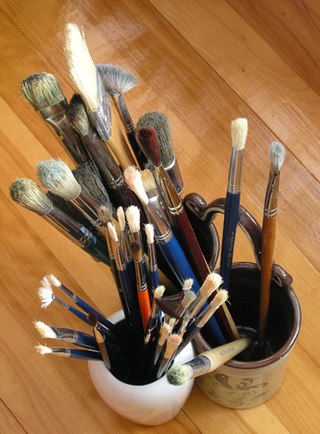
Leg shaving is the practice of removing leg hair by shaving the hair off using a razor or electric shaver. In addition, some people remove leg hair using waxing, sugaring, depilatories, epilators or other depilation devices, or lasers, but shaving remains the least expensive and one of the least painful methods.

Shaving is the removal of hair, by using a razor or any other kind of bladed implement, to slice it down—to the level of the skin or otherwise. Shaving is most commonly practiced by men to remove their facial hair and by women to remove their leg and underarm hair. A man is called clean-shaven if he has had his beard entirely removed.

A razor is a bladed tool primarily used in the removal of body hair through the act of shaving. Kinds of razors include straight razors, safety razors, disposable razors, and electric razors.

A mug is a type of cup typically used for drinking hot drinks, such as coffee, hot chocolate, or tea. Mugs usually have handles and hold a larger amount of fluid than other types of cups. Typically, a mug holds approximately 240–350 ml of liquid. A mug is a less formal style of drink container and is not usually used in formal place settings, where a teacup or coffee cup is preferred. Shaving mugs are used to assist in wet shaving.

A hairbrush is a brush with rigid or light and soft spokes used in hair care for smoothing, styling, and detangling human hair, or for grooming an animal's fur. It can also be used for styling in combination with a curling iron or hair dryer.

A bristle is a stiff hair or feather, either on an animal, such as a pig, a plant, or on a tool such as a brush or broom.

Shaving cream or shave cream is a category of cream cosmetics used for shaving preparation. The purpose of shaving cream is to soften the hair by providing lubrication.

An electric shaver is a razor with an electrically powered rotating or oscillating blade. The electric shaver usually does not require the use of shaving cream, soap, or water. The razor may be powered by a small DC motor, which is either powered by batteries or mains electricity. Many modern ones are powered using rechargeable batteries. Alternatively, an electro-mechanical oscillator driven by an AC-energized solenoid may be used. Some very early mechanical shavers had no electric motor and had to be powered by hand, for example by pulling a cord to drive a flywheel.

A straight razor is a razor with a blade that can fold into its handle. They are also called open razors and cut-throat razors. The predecessors of the modern straight razors include bronze razors, with cutting edges and fixed handles, produced by craftsmen from Ancient Egypt during the New Kingdom. Solid gold and copper razors were also found in Ancient Egyptian tombs dating back to the 4th millennium BC.

In cosmetology, exfoliation is the removal of the surface skin cells and built-up dirt from the skin's surface. The term comes from the Latin word exfoliare. This is a regular practice within the cosmetic industry, both for its outcome of promoting skin regeneration as well as providing a deep cleanse of the skin barrier. Being used in facials, this process can be achieved by mechanical or chemical means, such as microdermabrasion or chemical peels. Exfoliants are advertised as treatments that enhance beauty and promote a youthful and healthy appearance.

Schick is an American brand of personal care products and safety razors which was founded in 1926 by Jacob Schick. It is currently owned by Edgewell Personal Care.

Ingrown hair is a condition where a hair curls back or grows sideways into the skin. The condition is most prevalent among people who have coarse or curly hair. It may or may not be accompanied by an infection of the hair follicle (folliculitis) or "razor bumps", which vary in size. While ingrown hair most commonly appears in areas where the skin is shaved or waxed, it can appear anywhere. Anything that causes the hair to be broken off unevenly with a sharp tip can cause ingrown hairs. Ingrown hairs are also caused because of lack of natural exfoliation in the skin.

Horse grooming is hygienic care given to a horse, or a process by which the horse's physical appearance is enhanced for horse shows or other types of competition.
Barbasol is an American brand of shaving cream, aftershave, and disposable razors created by MIT Professor Frank Shields in 1919 in Indianapolis. It is currently owned by Perio, Inc.

Dog grooming refers to the hygienic care of a dog, a process by which a dog's physical appearance is enhanced for showing or other types of competition. A dog groomer is a professional responsible for maintaining a dog’s hygiene and appearance by offering services such as bathing, brushing, hair trimming, nail clipping and ear cleaning.
Taklon is the common name for a synthetic fiber used in artist-quality paint, makeup, shaving and pin stripe brushes. It is a smooth, soft, and somewhat fragile polyester derivative devoid of any protein component or allergen elements and is therefore used in the cosmetic industries as a "green," "vegan," "allergy free" or synthetic alternative to animal hair brushes.

Shaving soap is a hard soap that is used to produce lather with a shaving brush. The lather it produces is used to coat the face during shaving, softening the hair in preparation for shaving.

A makeup brush is a tool with bristles, used for the application of makeup or face painting. The bristles may be made out of natural or synthetic materials, while the handle is usually made out of plastic or wood. When cosmetics are applied using the appropriate brush, they blend better onto the skin.

A paintbrush is a brush used to apply paint or ink. A paintbrush is usually made by clamping bristles to a handle with a ferrule. They are available in various sizes, shapes, and materials. Thicker ones are used for filling in, and thinner ones are used for details. They may be subdivided into decorators' brushes used for painting and decorating and artists' brushes use for visual art.






















